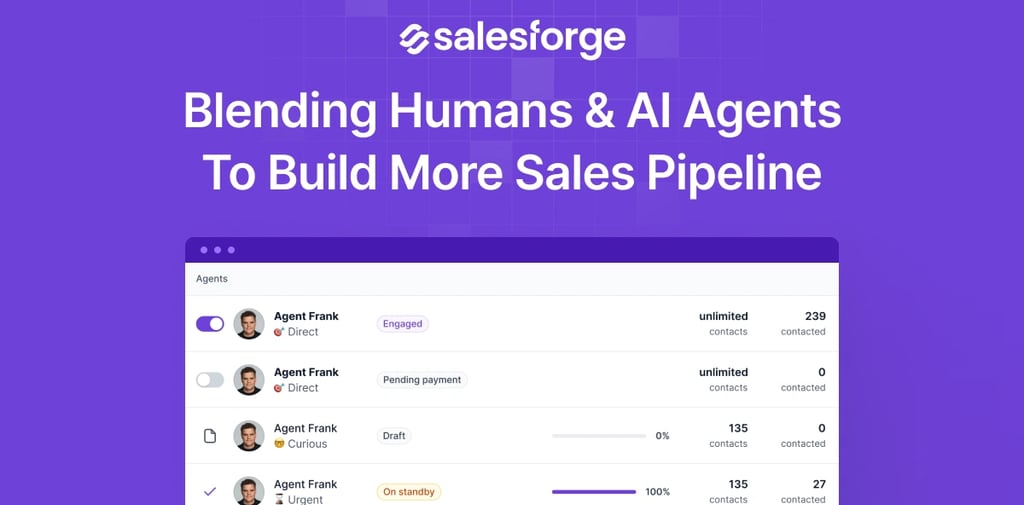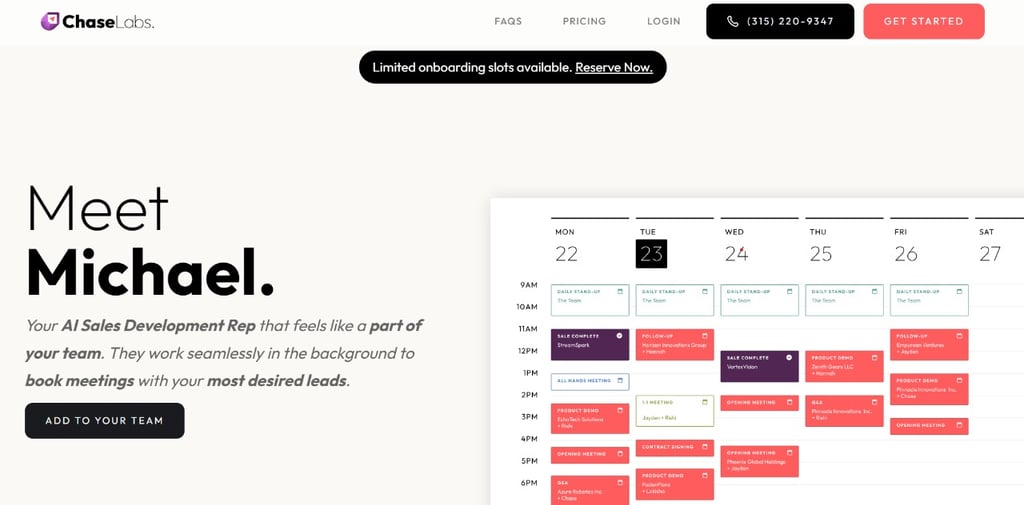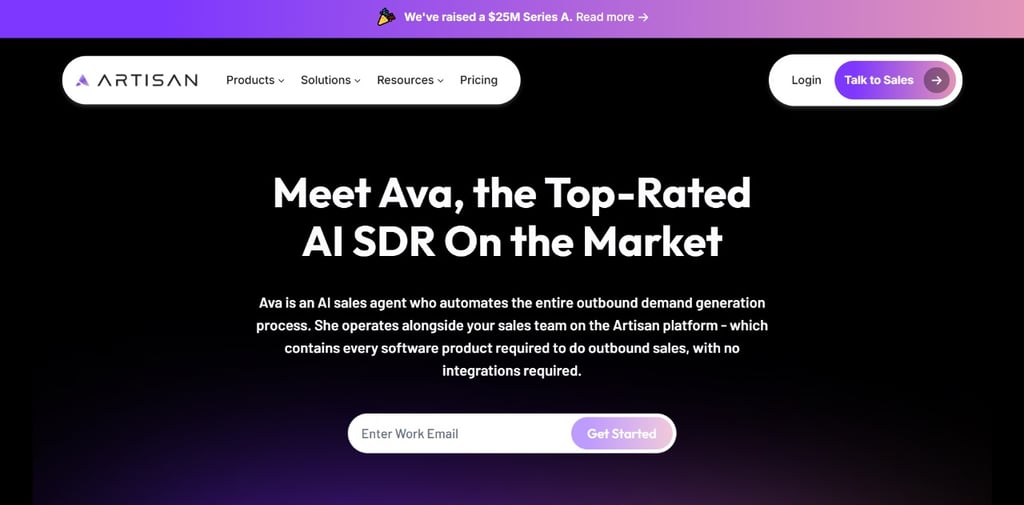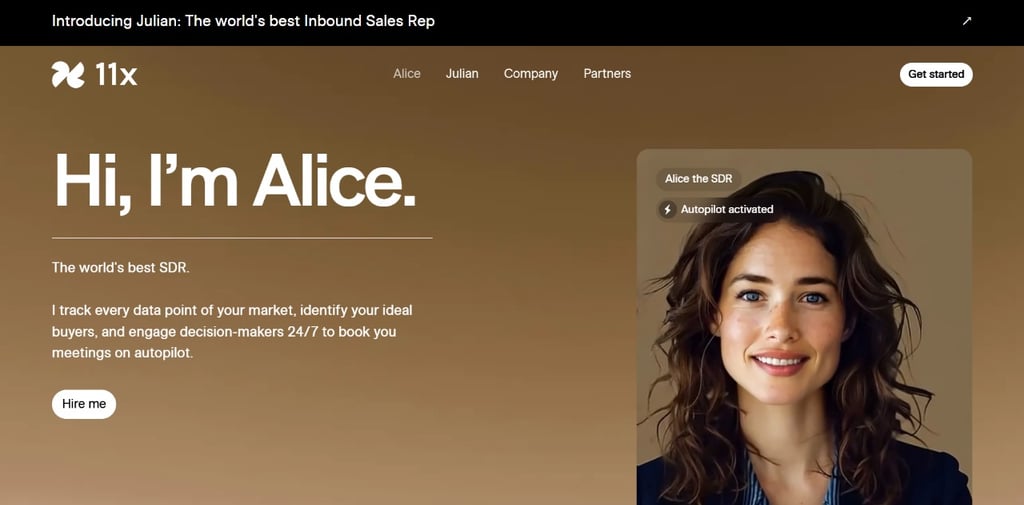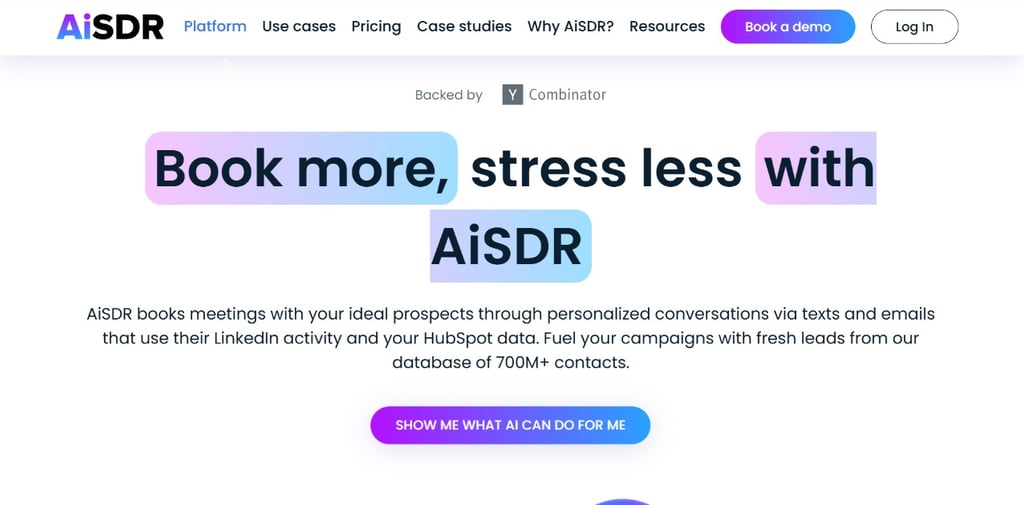The Truth About AI SDRs: Insights from 6 Months of Hands-On Use
Ali Adursh
7/7/202512 min read


In 2023, less than 5% of B2B sales activities were powered by generative AI technologies, but by 2028, that number will be 60%. Outbound sales have always been a manual, time-consuming process with countless follow-ups, spreadsheet tracking, and administrative tasks eating up valuable selling time. Today, AI SDRs are changing the landscape, automating the grunt work that has plagued sales teams for so long.
Only 17% of sales reps hit 90% or higher of their quota, so the potential for AI sales agents to improve performance is huge. What is an AI SDR? Simply put, it’s an artificial intelligence tool that handles the repetitive parts of sales development – from prospecting to initial outreach and follow-up. These AI-powered SDR solutions can automate over 80% of manual tasks, so human SDRs can focus on higher-priority tasks. Plus, companies using SDR tools powered by AI are 21 times more likely to convert leads when they respond within 5 minutes – a consistency that human teams can’t maintain.
**What is an AI SDR
What sets AI SDRs apart in sales development is their ability to revolutionize the way you approach top-of-funnel sales activities. That's where these AI-powered virtual reps come in. They can have genuine conversations with prospects, thanks to machine learning and natural language processing.
At their core, AI SDRs take over the time-consuming tasks that sales teams used to do by hand. Outreach, lead qualification, scheduling meetings, and following up with prospects are just a few of the tasks they excel at. In many ways, they're like the extra team members you never knew you needed.
**What AI SDRs Can Do Better (and Faster)
By automating those repetitive tasks, AI SDRs free up over two and a half hours of your sales team's time every day. That's time your reps can devote to what matters: building relationships and closing deals. Where AI SDRs truly shine in sales development is in that time and the results you get from it.
Autonomous Lead Research and Enrichment
AI SDRs pull prospect information from multiple sources at once, eliminating manual research. They scan websites, LinkedIn profiles, and other digital footprints to build full prospect profiles. So AI lead enrichment runs 24/7 in real-time, cross-checking information for accuracy.
Hyper-Personalization at Scale
Modern AI SDRs analyze hundreds of data sources to craft outreach that feels like it was researched individually. According to HubSpot, 43% of sales professionals agree that AI helps them uncover insights they wouldn’t otherwise find. Some platforms can generate personalized emails 60- 120x faster than human SDRs, based on:
Recent company news and announcements
Job changes and career milestones
Mutual connections and shared experiences
Industry-specific pain points
24/7 Pipeline Coverage
Unlike human SDRs who are limited to business hours, AI sales agents work around the clock, responding to leads no matter the time zone or day of the week. This means immediate lead engagement, especially critical since responding within 5 minutes increases conversion rates.
Data-Driven Decision Making
AI SDRs are great at analyzing response patterns and engagement metrics. Through machine learning, they get better over time, automatically adjusting outreach based on performance data. They also use predictive lead scoring, ranking prospects based on likelihood to convert, so sales teams can prioritize high opportunity leads.
Multi-Channel Campaign Management
Beyond email, AI SDRs now manage outreach across LinkedIn, text messaging, and other channels. They handle follow-up sequences, adjust timing based on engagement, and route qualified leads to the right sales reps. This means a seamless experience for the prospect and consistent messaging across all touchpoints.
**Where Human SDRs Still Win
Despite all the advancements in AI, human SDRs still excel in several areas where AI can’t yet compete. First and foremost, emotional intelligence is a uniquely human strength in the sales development process.
Emotional Intelligence Drives Complex Sales
Human sales reps have the empathy to read subtle emotional cues, adjust mid-conversation, and build rapport with prospects. Research shows emotionally intelligent salespeople excel at consultative selling because they know their strengths and weaknesses and can adapt to others’ emotional states. This emotional quotient (EQ) creates trust and positive experiences that drive sales.
Multi-Stakeholder Engagements
Complex B2B sales involve multiple teams with multiple stakeholders—more like “surviving Squid Games than playing Whack-A-Mole,” as one expert puts it. Human SDRs win in these situations by:
Understanding each stakeholder group’s unique dynamics
Tailoring messaging for different decision-makers
Making sure everyone feels heard and appreciated throughout the process
Unpredictable Objections
AI SDRs follow scripts well but falter when faced with unexpected objections or complex questions. Human sales reps can think on their feet and come up with creative solutions to overcome resistance.
Cultural Nuance and Strategic Thinking
Human SDRs adapt to cultural context—something AI struggles with. For example:
APAC: Focus on group consensus
Europe: Direct communication
Latin America: Relationship-first selling
Middle East: Status-aware messaging
Interestingly, this human advantage extends beyond individual calls to relationship building over time. Human SDRs build connections that create long-term loyalty, especially for high-value enterprise deals with long sales cycles.
As sales get automated, these human capabilities mean skilled salespeople are still essential in complex selling environments.
**5 Best AI SDRs
AI SDRs have changed everything for us. According to Salesforce, 83% of sales reps who use AI for lead gen see results vs those who don’t. We’ve been manual prospecting for years and decided to test if these tools deliver.
Instead of hiring 5 human SDRs at $60K each per year, companies can deploy AI SDR tools for $1K- $5K per month and get personalization at scale. We saw a 40% increase in meeting conversion rates with these AI solutions. While AI sales prospecting tools can engage thousands of leads at once, 24/7, we wanted to see how they performed in real-world conditions.
For the last 6 months, we’ve tested 5 leading AI sales agents, documenting every success and failure along the way. Instead of trusting vendor claims, we put each AI SDR tool through the same scenarios across different industries. The results were shocking – these tools saved our team 2 hours and 15 minutes per day on lead gen tasks from research to meeting scheduling. McKinsey estimates AI will add $1 trillion to sales and marketing productivity – but which tools deliver?
Agent Frank
Agent Frank is a powerful AI SDR in the Salesforge platform. During our testing period, we found this AI agent to be great at streamlining our outreach without sacrificing personalization.
Agent Frank's key features
Agent Frank has two modes – Auto-Pilot for full autonomy and Co-Pilot for human oversight. Plus 24/7 automated prospecting that continuously finds and processes new leads based on your criteria. The agent handles the entire sales pipeline from first contact to meeting scheduling.
And:
AI-generated personalized emails to each prospect
Smart sequencing based on prospect behavior
Automated follow-ups without manual intervention
Real-time analytics to track campaign performance
Multi-language support across 20+ languages
Agent Frank pricing
Agent Frank is $499/month when billed quarterly. Annual billing gets you 2 months free. This is for management of 1,000 active contacts at a time, which is about 2,000-2,500 new leads per month.
Infrastructure costs are 5 domains ($65/year) and 10 mailboxes ($120/quarter) through Infraforge . So the total quarterly infrastructure cost is about $185.
Agent Frank's pros and cons
Pros: Agent Frank was very cost-effective during our testing, 10X cheaper than human SDRs. We deployed faster and got higher engagement with personalized messaging. When used in native languages, it has 2X higher reply rates.
Cons: Agent Frank can’t do cold calling due to US regulations. It’s not suitable for complex enterprise sales cycles with long decision processes. We had a learning curve during setup as the system requires good-quality data to perform well.
Agent Frank best for
Agent Frank is best for B2B sales teams in SMB and mid-market. After testing, we found it to be good for pipeline generation, increasing coverage, and scaling cold outreach. Teams entering new markets will love the multilingual capabilities and personalization features.
MeetChase
MeetChase stands out from other AI SDR tools by focusing on booking quality meetings over quantity. Over our 6-month testing period, we’ve seen firsthand how this approach advances the sales pipeline.
MeetChase features
MeetChase is an autonomous AI sales agent with the following features:
Full-Cycle Lead Nurturing - Multi-channel outreach orchestration and dynamic sequence adjustment based on response patterns
Intelligent Lead Qualification - Match leads to your ICP and multi-touch engagement patterns
Custom AI Persona Integration - Create a personalized SDR identity on your domain that maintains a consistent communication style
Intelligent Meeting Management - Auto no-show follow-ups and integrates with your calendar
MeetChase pricing
MeetChase has a results-based pricing model where you pay only for meetings booked:
Your Leads Plan: $50 per meeting when you provide the leads. Auto-Pilot Plan: $60 per meeting, including lead sourcing and outreach. Enterprise Plan: Custom pricing for larger teams
Monthly price caps can be set based on your requirements, making this scalable for businesses of all sizes.
MeetChase pros and cons
Pros: Lead nurturing and meeting scheduling that saves time. Flexible pay-per-meeting pricing aligns with results. White-glove service for prospects enhances the customer experience
Cons: Higher cost per meeting can be expensive for smaller teams running high-volume campaigns. Less control over outreach volume as MeetChase handles outreach autonomously
MeetChase best for
After testing, we found MeetChase is best for companies that prioritize quality over quantity in their AI sales prospecting efforts. The tool books meetings that actually move the pipeline forward, so the ROI calculations are more favorable despite the higher per-meeting cost. Ultimately, MeetChase is best for B2B companies with longer sales cycles that need consistent personalized follow-up to nurture leads effectively.
Artisan Ava
Artisan’s Ava acts as a full AI BDR (Business Development Representative) that handles about 80% of our outbound tasks during testing. This conversational AI assistant did a great job of handling the entire outbound sales process on its own.
Artisan Ava features
Ava does more than just basic automation:
Intent-driven lead discovery that finds prospects that are buying
Waterfall personalization for super customized emails that get more engagement
Automated follow-up management that moves leads through the pipeline
Access to over 300 million B2B contacts across 200+ countries
Email warmup feature that builds sender reputation to avoid spam filters
Sales playbooks with proven outreach strategies to implement consistently
Multi-channel outreach via email and LinkedIn
Artisan Ava pricing
Artisan has a volume-based pricing model based on the number of leads you contact. They don’t publicly disclose exact pricing but plans reportedly start between $1,500-$2,000/month with an annual contract. Some sources mention annual plans ranging from $12,000 for 12,000 leads per year to $65,000 for 65,000 leads.
Artisan Ava pros and cons
Pros:
Automates research across dozens of sources for rich prospect insights
Creates super personalized emails using multiple data points
Built-in deliverability tools to get messages into inboxes
Responsive customer support team with dedicated account managers
Cons:
Limited customization options for personalization approaches
Requires regular monitoring rather than set-and-forget automation
Not as effective for highly specialized or niche markets
Integration is limited to HubSpot and Salesforce
Artisan Ava best for
Overall, Ava was best for B2B SaaS startups that have achieved early product-market fit and need to scale outbound without adding headcount.
We found Ava most valuable for companies with standard B2B sales processes and clearly defined ICPs. However, it may not be ideal for complex enterprise sales cycles that require nuanced messaging or extensive customization.
11x.ai Alice
The 11x Alice AI sales agent worked 24/7 throughout our testing period. Unlike other SDR tools, Alice is a full digital employee, not just another automation platform.
11x Alice features
Alice is a full SDR autopilot with more than automation:
Deep personalization that analyzes prospect behavior across social, public, and engagement data to craft winning strategies
Autonomous prospecting that prospect, reply, and schedule meetings 24/7
Multi-channel engagement via email and calls with custom sequences
Lead resurrection that rekindles old conversations from your CRM
Multi-language support to expand to international markets in over 105 languages
11x.ai Alice pricing
Based on data, 11x.ai Alice has a median contract value of $43,500 per year. They offer upgrades and downgrades, so it’s flexible as your business changes. We asked and found that the Advanced package includes 3,500 new prospects per month, up to 5 users, CRM integration, and domain creation with warm-up.
11x.ai Alice pros and cons
Pros: In our testing, Alice increased meetings per AE by 30% and meeting-to-qualified opportunity conversion by 80%. It also reduced the cost per lead by 50%. The continuous learning from billions of data points gets better and better over time.
Cons: We found a big gap between the promised and actual results. The main issue was deliverability. Also, the setup required a lot of configuration to integrate with specific business processes. Several users reported high churn rates, so there might be satisfaction issues.
11x.ai Alice best for
Ultimately, Alice is best for tech startups and B2B companies that need to scale fast without adding headcount. Specifically, we found it good for companies that want to automate prospecting while keeping personalization across multiple channels.
AiSDR
For 6 months, we tested AiSDR, and it’s a full sales automation platform with amazing personalization capabilities. Currently serving 150+ companies, this AI SDR tool combines lead generation with advanced engagement features in one system.
AiSDR features
AiSDR finds high-intent leads matching your ideal customer profile through multiple methods:
Lead finder searches Sales Navigator, ZoomInfo, and proprietary databases
Intent signals search social media, tech stacks, news, and job vacancies
Website visitor tracking identifies and enriches anonymous site visitors
Lookalike search finds companies similar to your best customers with 97% match rate
In addition to prospecting, AiSDR creates personalized outreach using up-to-date prospect data from LinkedIn, company updates, and CRM records. The platform personalizes using 323+ data sources, resulting in deeply contextual messages that generate 1-3 demos per 100 leads.
AiSDR pricing
AiSDR has transparent pricing based on message volume. The Basic Plan is $750 per month for 1,000 personalized emails and texts. This includes unlimited leads, domain warm-up and bounce checks as standard features. Additional emails are $7.50 for every 10 extra messages. No hidden fees, you can cancel anytime for any reason.
AiSDR pros and cons
Pros:
Triple verifies contact details so high deliverability (<5% bounce rate)
Conversational emails that sound like you using 50+ built-in sales frameworks
24/7 customer support with a dedicated GTM engineer
Integrates with HubSpot, Gmail, and Outlook
Cons:
Occasional inconsistency in AI-generated content quality
Limited integrations (Salesforce integration not until 2025)
Not suitable for complex enterprise sales processes
AiSDR best for
AiSDR is best for companies that want to automate repetitive outreach tasks at scale. It’s super effective for B2B businesses doing high-volume prospecting and those entering new markets because of multi-language support. Indeed, it’s best when you have a clear value proposition and customer profile, so it’s perfect for focused outbound campaigns that require consistent follow-up and personalization.
**How to Use AI SDR in Your Sales Strategy
Step 1: Audit Your Sales Process
Start by identifying repetitive, time-consuming tasks in your current sales process that can be automated, like cold outreach, lead enrichment, or follow-ups. Don’t assign AI tasks that require human judgment, emotional intelligence, or relationship management.
Step 2: Choose the Right AI SDR Tool for You
Pick a tool based on your sales strategy. For example, if you’re outbound, choose a tool that’s designed for prospecting and cold outreach. Don’t retrofit an inbound chatbot for outbound sales. Make sure the AI SDR aligns with your use case, target market, and tech environment.
Step 3: Integrate with Your CRM and Sales Tech Stack
Make sure your AI SDR integrates with platforms like HubSpot, Salesforce, or Pipedrive. This will allow you to:
Sync lead data in real time
Do not contact existing customers
Re-engage cold leads
Build qualified pipelines
Create custom workflows with generative AI
Also, integrate with task management tools (e.g., ClickUp, Monday, or via Zapier) to automate task assignments and team updates, so you don’t have to micromanage.
Step 4: Set Clear KPIs for Success
Define measurable goals for your AI SDR. Common KPIs are:
Number of qualified leads generated
Meetings scheduled
Email open/reply rates
Time to move a lead into the pipeline
Track early and often to spot areas to improve or adjust.
Step 5: Train and Align Your Team
An AI SDR isn’t a “set-and-forget” solution. Provide onboarding and training so your team knows how to work alongside the AI. Work with your tool’s support team to educate SDRs on workflows, data input, and best practices for human-AI collaboration.
Step 6: Start with Supervised Automation
Initially, monitor and approve AI actions manually. As you get more comfortable, reduce manual intervention and let the AI SDR do more and more steps on its own—only jumping in when human input is required (e.g., responses, complex objections, negotiation stages).
Step 7: Connect AI Insights to Marketing and Content
Make sure the data the AI SDR collects flows back into your overall sales and marketing strategy. AI interactions can inform content, email copy, and campaign targeting.
Future of AI SDRs
AI is no longer a future thing—it’s part of today’s sales and will only get bigger. Instead of fearing disruption, smart companies are seeing AI SDRs as a vital asset for driving scalable, efficient, and consistent sales outreach. These intelligent tools aren’t here to replace human salespeople but to enable them by taking over time-consuming, repetitive tasks like lead research, outreach scheduling, and CRM data entry.
As sales teams get more stretched and outbound prospecting increases, AI SDRs like Artisan are becoming essential allies. They let reps focus on what really matters—building trust, nurturing relationships, and closing deals—while the AI does the heavy lifting behind the scenes.
By using AI SDR,s companies can improve lead response times, maintain consistent engagement, and personalize outreach at scale—factors that directly impact conversion rates. And in a data-driven economy where speed and precision matter, AI SDRs help businesses be agile, competitive, and better equipped to adapt to buyer behavior.
